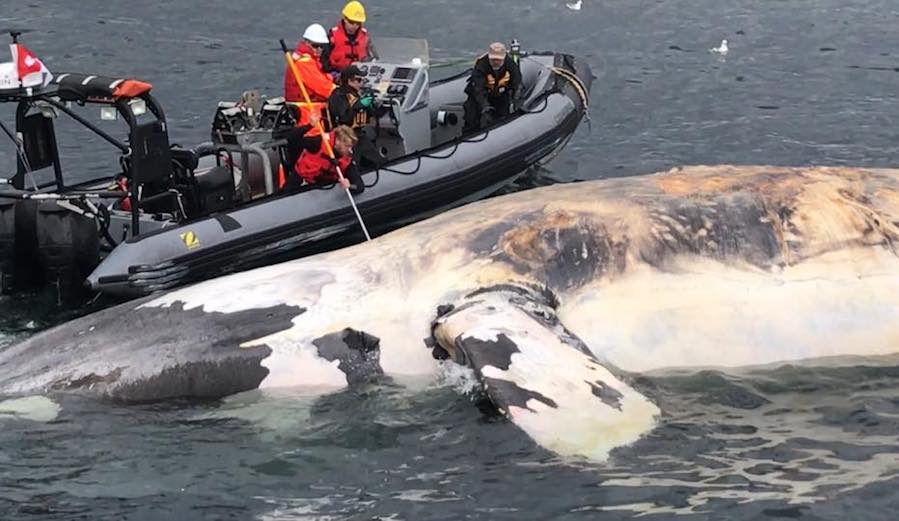
Representatives from the Marine Animal Response Society take samples from a recently discovered 47ft North Atlantic right whale. Photo: Marine Animal Response Society
Something odd is going on in the Gulf of St. Lawrence. Six North Atlantic right whales were found dead off the Canadian coastline in the month of June alone. That may not sound like much at first, but when you consider that there are less than 500 of these endangered whales left in the North Atlantic the picture becomes a little clearer. It means that more than one percent of the North American right whale population just vanished in a span of less than three weeks.
This string of deaths was referred to as an “unprecedented event” by Tonya Wimmer, a marine biologist and director of the Marine Animal Response Society. Wimmer said that losing a single animal from this population is huge, calling the loss of six in such a short period of time “catastrophic.” At least two of the whales were female, which further impacts the reproduction capacity of this endangered species.
The cause of death relating to these animals has not been determined, and there is nothing that seems obvious at this point. The only way to ascertain what killed these whales appears to be a necropsy, which is basically an autopsy on an animal as opposed to a human. Department of Fisheries and Oceans Canada biologist Cathy Merriman said that a necropsy was of the highest priority in this situation.
A timetable for such an examination hasn’t yet been disclosed, though, as there is a multitude of challenges regarding this process. The biggest obstacle? These whales are massive. An average North Atlantic right whale measures between 43 and 52 feet in length, and they can weigh over 200,000 lbs. Picture towing such an animal for more than 20 miles and all the issues one could face in doing so. It’s common for large parts of the whale to fall off, and the animal itself can simply sink before it reaches shore.
This series of deaths is most definitely alarming, especially when dealing with a species whose population is so low already. Obviously, the shared history of humans and whales is a dicey one at best. These leviathans used to be thought of in the same vein as sharks, as mindless sea monsters that wanted nothing more than to kill us. That myth eventually faded, but at a huge cost to the whale population. Unfortunately for sharks, their stigma remains.
Right whales, in particular, were relatively easy for whalers to catch. They are not particularly fast, and the fact that they float on the surface after they die allowed for the extraction of blubber without bringing the whale onto the ship. By the time it became clear that hunting right whales was an unsustainable practice, the population had already dwindled to a disturbing level.
Nobody is sure what killed these six whales in June, and it will likely take time to achieve any clarity on the issue.

